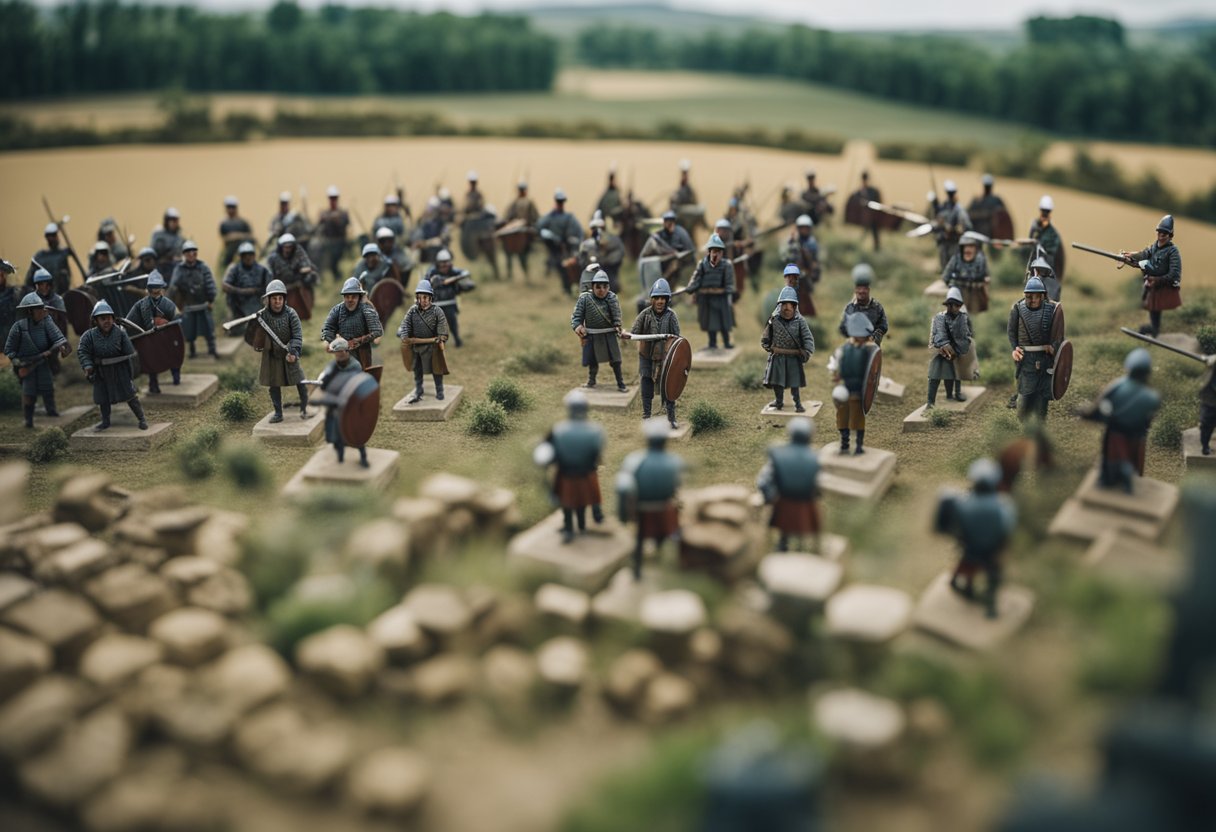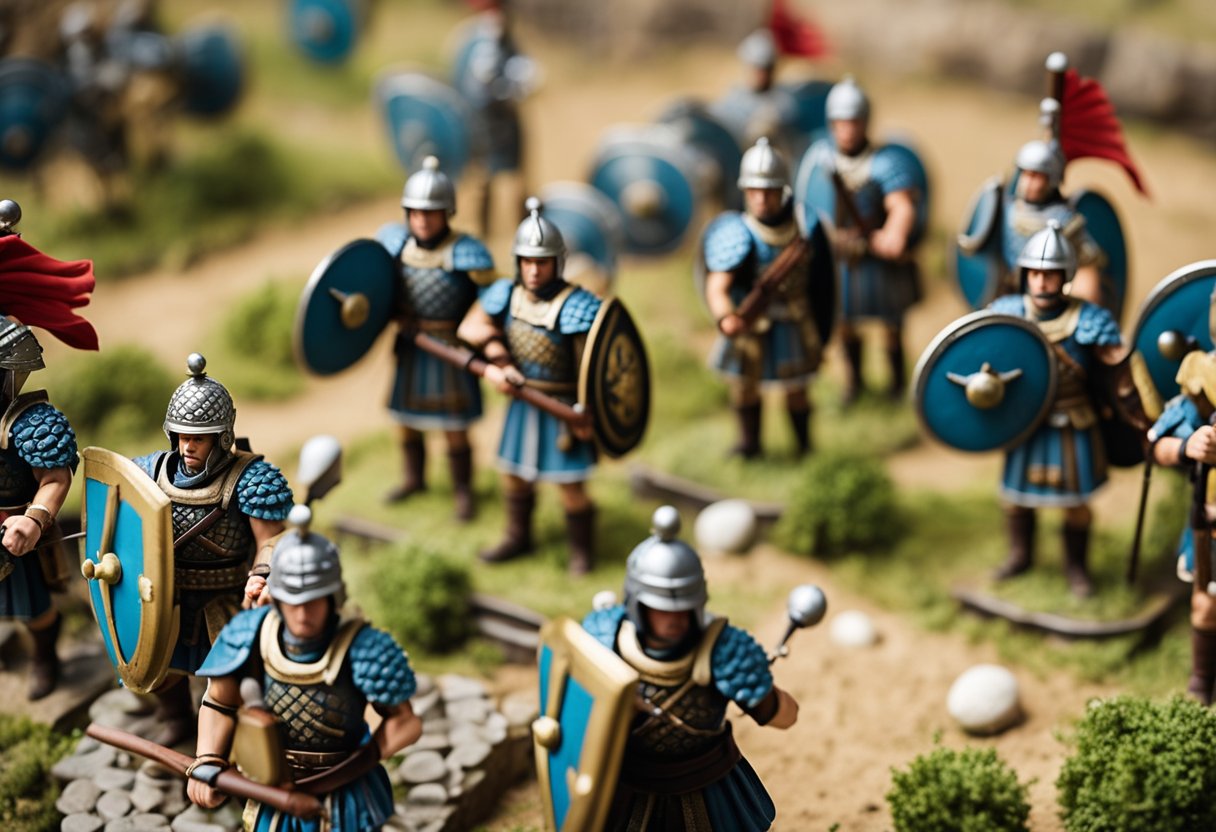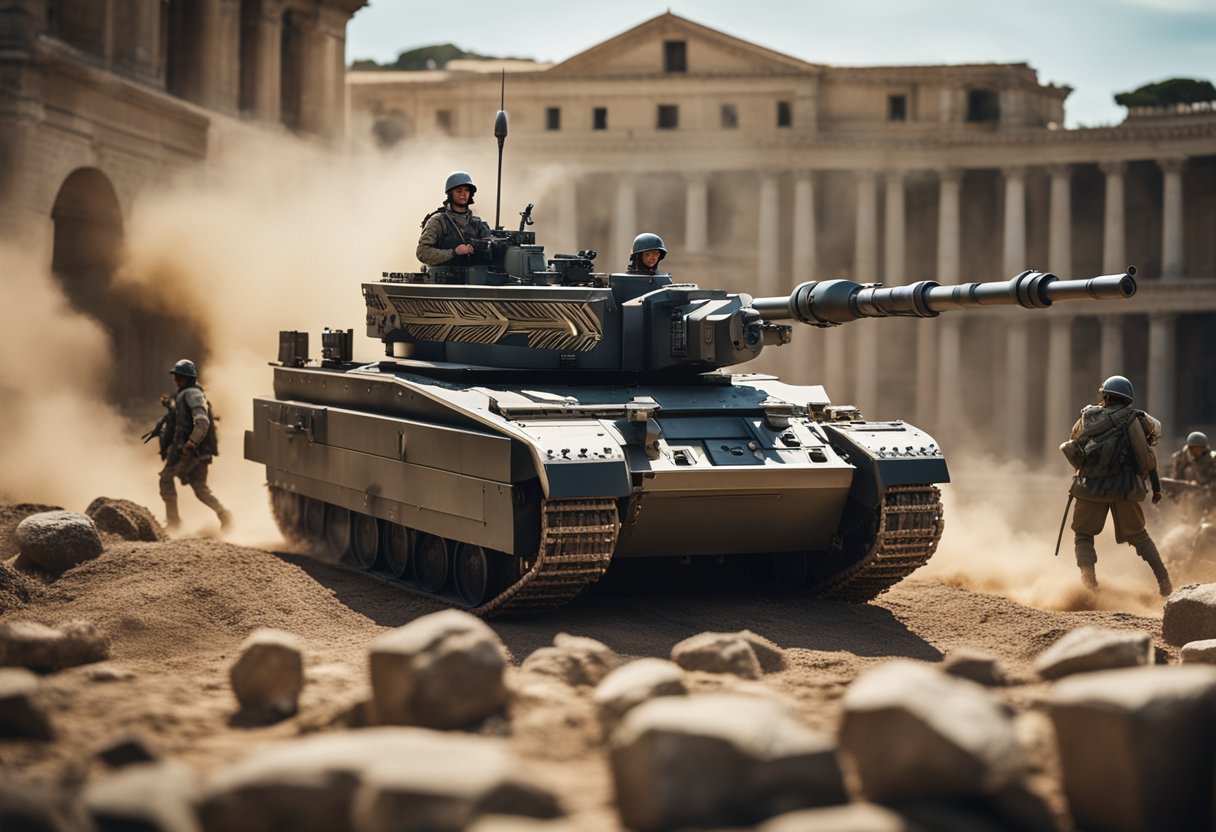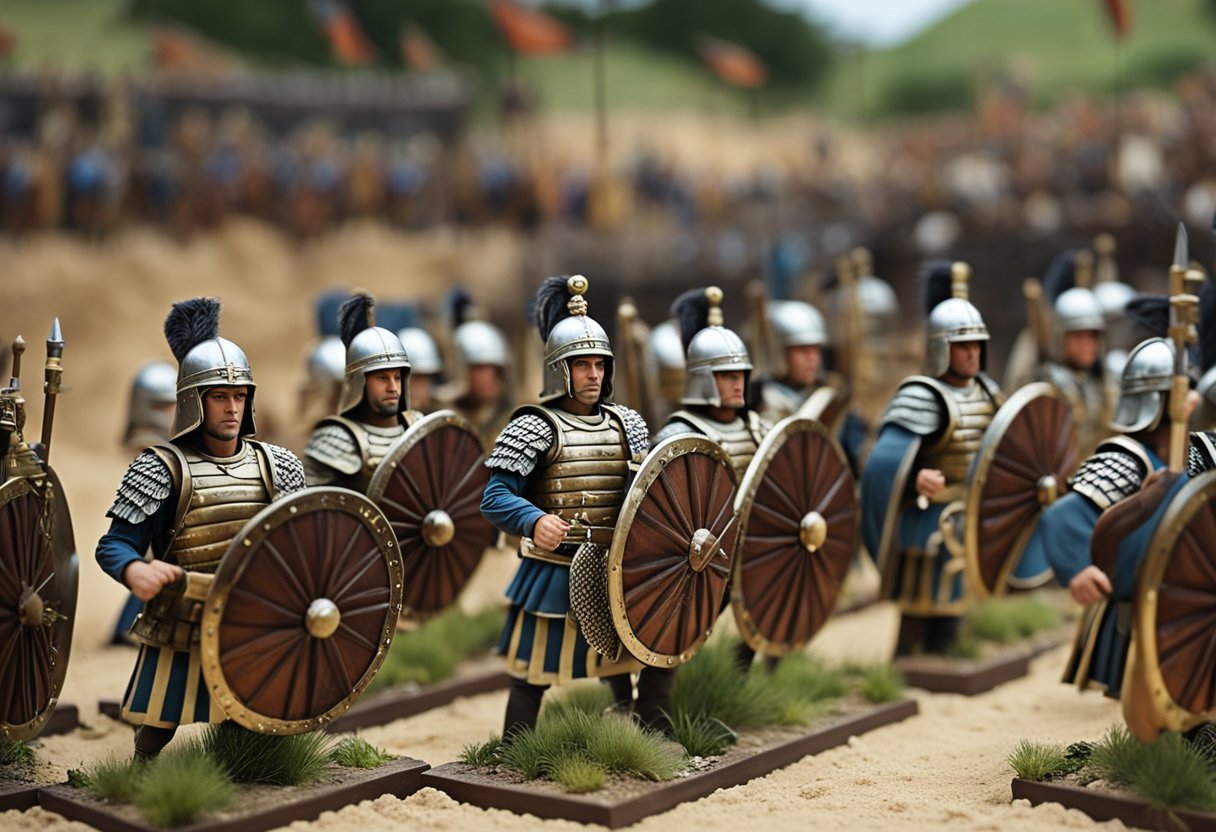The Romans are often considered a highly skilled civilization, known for their military prowess and expansive empire. Historically, there has been a debate among scholars whether the Romans were capable of strategic thinking. Recent research, however, challenges this perception and sheds light on the various aspects of Roman strategic thinking.


From the foundations of their military strategy to their diplomatic endeavors and key battles, the Romans demonstrated an ability to apply strategic thought in managing their vast empire. Through their well-organized military machine, the Roman society could coordinate large armies while ensuring an effective governance system that enabled them to maintain their dominance and stability for centuries.
Key Takeaways
- Romans demonstrated strategic thinking in managing their vast empire.
- Their military machine helped coordinate large armies and maintain dominance.
- Roman diplomacy played a significant role in their overall strategy.
Foundations of Roman Military Strategy


Inception of the Roman Republic
The Roman Republic, founded in 509 BC, heavily relied on their military strategy to achieve dominance and expand their territories. Their strategic thinking was exhibited in the organization of their legions, the way they trained their soldiers, and their ability to adapt to various situations on the battlefield. A key aspect of the Roman military strategy was its use of formations, which allowed them to counterbalance weaknesses and support strengths1. The Romans placed great emphasis on terrain, as well as the type and strength of both their own and enemy troops2.
Roman Empire’s Expansion
As the Roman Empire expanded, so did its need for a more sophisticated and flexible military strategy. During this period, the Roman military developed tactics and formations that enabled them to maintain stability over the 2.75 million square miles they occupied3. It was their strategic thinking, adaptable troop composition, and flexible deployment that contributed to their success in creating and maintaining such a vast and stable empire4.
Roman military strategy was not only about deploying troops effectively but also about diplomacy backed by the threat of military action5. This demonstrates that strategic thinking was ingrained in the Roman Empire’s entire approach to expanding its territories and retaining control.
The Roman Military Machine


Legion Formations and Tactics
The Roman military was renowned for its organization and strategic thinking. An essential aspect of their strategy was the effective use of legion formations and tactics. The Roman legions were typically composed of around 6,000 soldiers and were known for their flexibility on the battlefield. Roman soldiers were trained to adapt to various scenarios, taking into account terrain and the strength of enemy forces.
Some common formations used by the Roman legions included the testudo (tortoise) formation, which provided protection from projectiles; the triplex acies (triple battle line) formation, consisting of three lines with different types of infantry; and the orbis (circle) formation, used as a defensive measure. These formations allowed the Romans to optimize their capabilities and counteract weaknesses during battle.
Role of Infantry and Cavalry
The Roman military was mainly composed of two types of forces: infantry and cavalry. The infantry, which formed the core of the Roman military, were heavy and light infantry soldiers. The heavy infantry, known as legionaries, wore armor and wielded swords, while the light infantry, called auxiliaries, carried slings and other missile weapons.
In addition to the infantry, the Roman military also incorporated cavalry units known as equites. These mounted soldiers were vital for reconnaissance, flanking maneuvers, and rapid pursuit of retreating enemies. The combination of infantry and cavalry allowed the Romans to maintain a balanced and versatile fighting force.
Reserves and Troop Management
Reserves played a crucial role in the Roman military strategy. Troops were often held in reserve to replace exhausted or depleted units, allowing for a continuous fighting force. This approach was vital in achieving their operational strategy and ensuring that the legions maintained their combat effectiveness throughout battles.
Roman commanders were skilled in troop management, utilizing a variety of techniques to keep their soldiers well-supplied, well-rested, and ready for action. Through strategic planning and the rotation of forces, the Roman military was able to preserve its strength and continue fighting without diminished capacity.
In summary, the Roman military machine relied on a combination of strategic planning, disciplined formations, and the effective use of infantry and cavalry to achieve its goals. By leveraging a range of tactics and carefully managing their troops, the Romans were able to maintain a powerful military presence and dominate the battlefield throughout their empire’s history.
Roman Strategic Practices


Coordination and Order
The Romans were known for their ability to maintain a high level of coordination and order in their military operations. They used a structured organization, with hierarchies and rank systems that allowed for efficient command and control of their troops. Their units were divided into legions, each consisting of several thousand soldiers and led by a legionary commander, known as a legate.
In battle, Roman soldiers adopted various formations depending on the situation. The most well-known formation was the testudo, or tortoise, which involved soldiers forming a tight shield wall to protect themselves from enemy projectiles. This formation allowed them to advance slowly but safely, thus maintaining order on the battlefield.
Usage of Technology and Infrastructure
The Romans excelled in their usage of technology and infrastructure to facilitate strategic operations. They constructed a vast network of roads and bridges that enabled their armies to move quickly and easily across the empire. This infrastructure not only accelerated the movement of troops, but it also enabled supplies and information to be transported efficiently.
In addition to their impressive engineering feats, the Romans also integrated technology in their warfare practices. Their inventive siege engines, such as the catapult and ballista, allowed them to breach enemy fortifications with relative ease. This technological prowess helped secure the Roman Empire as a dominant power in the ancient world.
Adaptation in Warfare
One of the keys to Rome’s long-term success was their ability to adapt their strategies in response to evolving challenges from their enemies. As they encountered different opponents with varying tactical approaches, Romans analyzed and learned from them, often incorporating new techniques or technologies into their own arsenal.
A notable example of Roman adaptation is their response to the military prowess of the Carthaginians, led by Hannibal during the Second Punic War. The Romans initially suffered significant defeats but eventually developed defensive strategies that neutralized the Carthaginian advantage in cavalry and elephants. By adapting to the unique challenges posed by their adversaries, the Romans demonstrated a hallmark of successful strategic thinking: flexibility and innovation.
Strategic Governance and Society
Political Structure and Bureaucracy
The Roman Empire was characterized by a complex political structure and an efficient bureaucracy that played a vital role in their strategic thinking. The political system consisted of two main levels: the central imperial government and the provincial administrations. The central government was responsible for the overall strategic decisions, while the provinces carried out the implementation of these strategies on a local level1.
A key feature of the Roman bureaucracy was its emphasis on order and structure. The Empire was divided into provinces, each governed by a Roman official who reported to the emperor2. This hierarchical structure allowed for a high degree of coordination and communication among different levels of governance, ultimately contributing to the successful execution of strategic plans.
Cultural Influence on Strategy
Roman culture and values greatly influenced the development and execution of the empire’s strategies3. Roman society placed a strong emphasis on virtues such as discipline, loyalty, and resilience, traits that were crucial for the success of their military campaigns. Moreover, the concept of pax romana, or Roman peace, was central to the empire’s strategic vision. Through consolidating their territories and establishing long-lasting peace, the Romans effectively expanded their influence and control over vast regions.
Roman strategy was also influenced by their pragmatic approach to diplomacy and alliances. They were skilled in identifying potential threats and neutralizing them through diplomatic means, rather than always resorting to military action4.
Economic Measures and Coinage
The Roman Empire’s economy played a critical role in supporting its strategic objectives. One notable example is the widespread use of Roman coins, which acted as both a means of exchange and a symbol of imperial power5. Coins were minted with the image of the ruling emperor, helping to promote the ruler’s authority and control over the empire’s vast territories.
The empire’s vast economic resources also allowed it to develop and sustain a powerful military, which was essential to the success of its strategic endeavors. The Romans established a remarkably efficient tax system that enabled them to finance large-scale infrastructure projects, such as roads, bridges, and aqueducts. These projects were not only crucial for the empire’s day-to-day functioning but also facilitated the rapid movement of Roman troops, aiding in the execution of military strategies6.
In summary, the Roman Empire’s strategic approach to governance and society was shaped by a complex interplay of political, cultural, and economic factors. Through a combination of a well-structured bureaucracy, cultural values that supported resilient military campaigns, and a robust economy, the Romans managed to create a highly effective strategic machine that enabled them to dominate their corner of the ancient world.
Key Roman Strategies and Battles
Confronting Hannibal: Punic Wars
During the Punic Wars, the Romans faced one of the greatest military strategists of all time, Hannibal. Hannibal’s tactics were well known, such as his famous crossing of the Alps into Italy. The Romans, however, demonstrated their strategic thinking by often relying on a counterstrategic approach. The most notable example is the Battle of Cannae in 216 BC, where Rome suffered a massive loss against Hannibal’s superior military strategy.
In response, the Romans adapted their tactics and adopted a strategy of attrition. They focused on cutting off Hannibal’s supplies and weakening his troops over time. The Fabian strategy, named after the Roman general Quintus Fabius Maximus, involved avoiding direct confrontations with Hannibal’s forces while gradually depleting their resources1.
Ultimately, Rome defeated Hannibal in the Battle of Zama in 202 BC, thanks to the combination of flexible strategic thinking and intelligence gathering2. This victory marked the end of the Second Punic War and showcased the Roman ability to adapt and overcome adversity in their military endeavors.
Trajan’s Campaigns and Grand Strategy
Emperor Trajan’s reign (98 – 117 AD) marked another significant period in Roman military history. Trajan was known for his grand strategy and his ability to use military power indirectly as an instrument of political warfare3. Under Trajan, the Romans expanded their empire to its greatest territorial extent.
His campaigns against the Dacians and Parthians are prime examples of his strategic prowess. In both cases, Trajan employed a combination of diplomatic efforts and military strength to achieve his objectives. For the Dacian Wars (101 – 102 AD and 105 – 106 AD), Trajan secured Rome’s northeastern frontier and gained valuable mineral resources from the conquered territory4.
The Parthian campaign (114 – 117 AD) showcased Trajan’s capacity to use manipulative diplomacy to weaken his adversaries5. By fostering disunity among potential enemies, Trajan ensured that Rome’s strategic interests were protected without fully committing to large-scale battles.
In conclusion, the Roman military demonstrated strategic thinking throughout their history. The strategic approaches employed during the Punic Wars and Trajan’s reign exemplify the Roman military’s adaptability and persistence in achieving their goals.
Roman Diplomacy and Foreign Policy
Negotiating with Other Societies
The Roman Empire was renowned for its diplomatic prowess and foreign policy strategies. Negotiating with other societies played a crucial role in Rome’s expansion and maintenance of territories. The Romans displayed a keen understanding of the dynamics of power and influence, enabling them to extract the most favorable terms during negotiations.
In most cases, Roman diplomacy revolved around establishing treaties of peace, alliance, and general agreements with other states. This strategy often utilized a mix of soft power (cultural and political influence) and hard power (military might) to persuade nations to align with Rome. Diplomats would emphasize the benefits of being a Roman ally, such as protection and trade opportunities.
Throughout their history, Rome’s diplomats engaged in various methods of negotiation, including:
- Diplomatic envoys: Sending ambassadors abroad to negotiate or gather intelligence
- Hostage exchanges: Offering to return captured persons in exchange for concessions
- Gifts and tributes: Presenting valuable items to create goodwill and loyalty
Alliances and Cultural Diplomacy
Alliances formed a vital component of the Roman Empire’s foreign policy. Rome created a network of allies and client states through strategic treaties, providing military support and access to resources in return for loyalty and cooperation. This approach allowed Rome to project power over vast regions without overstretching its resources and enabled rapid response to local threats or unrest.
Alongside military alliances, Rome also engaged in cultural diplomacy to establish influence and gain acceptance among other societies. This strategy involved promoting Roman culture, values, and language, fostering a sense of shared identity and collaboration. Examples of Roman cultural diplomacy include:
- Promoting Roman architecture and urban planning: Encouraging the construction of Roman-style buildings and infrastructure, such as temples, theaters, and baths, to facilitate cultural assimilation
- Supporting local elites: Empowering influential local figures who adopted Roman customs and values, further cementing Rome’s presence
- Educational exchange: Offering Roman education to the children of foreign elites, who would return to their homelands as advocates of Roman culture
Ultimately, the Roman Empire’s strategy of diplomacy and foreign policy greatly contributed to its expansion, stability, and renowned reputation. Rome’s ability to negotiate and form alliances with other societies showcased its strategic thinking and adaptability, enabling the empire to endure for centuries.
Assessment and Legacy
Analysis of Roman Strategic Thinking
Roman strategic thinking has often been debated by historians due to its complexity and variations across different periods. Throughout the empire’s history, Romans developed an effective approach to strategy that effectively combined military and political aspects. This approach allowed Rome to maintain its power for more than 500 years, even when facing numerous challenges from both internal and external sources1.
At the core of Roman strategy were three main objectives, which included maintaining the integrity and stability of the Empire, protecting it from external enemies, and expanding its borders when possible and profitable2. The Romans were able to achieve these goals by utilizing a sophisticated military system and adapting their tactics to specific situations.
Another key aspect of Roman strategic thinking was ensuring the survival of the emperor, with the Roman military playing a crucial role in sustaining the emperor’s rule3. This highlights the importance of not only a well-functioning military but also a stable political system to support the strategic plans of the empire.
Roman Strategic Influence on Modern Institutions
Roman strategic thinking has left a lasting legacy on modern institutions, as its principles can be traced to the development of later military and political strategies. The core concepts of Roman strategy have found their way into the strategic doctrines of numerous empires and states throughout history, and they continue to be relevant today.
By examining the strategic practices of the Roman Empire, modern institutions can gain a deeper understanding of how to develop effective strategies that take into account both military and political factors. This approach can not only lead to better decision-making but also enhance the overall effectiveness of military and political organizations4.
In conclusion, Roman strategic thinking, despite its intricacies, has had a significant impact on military and political institutions throughout history. By learning from the strategic lessons of ancient Rome, modern institutions can further refine their approaches to strategy and decision-making.
Footnotes
- Roman Culture/Military Strategy and Tactics – Wikibooks ↩ ↩2 ↩3 ↩4
- Formations of the Legion | Strategy & Tactics – Roman Military ↩ ↩2 ↩3 ↩4
- The Roman Army: Strategy, Tactics, and Innovation ↩ ↩2 ↩3 ↩4
- Strategy of the Roman military – Wikipedia ↩ ↩2 ↩3 ↩4
- Rome: Strategy of Empire – Oxford Academic ↩ ↩2 ↩3
- Rome: Strategy of Empire – ResearchGate ↩





